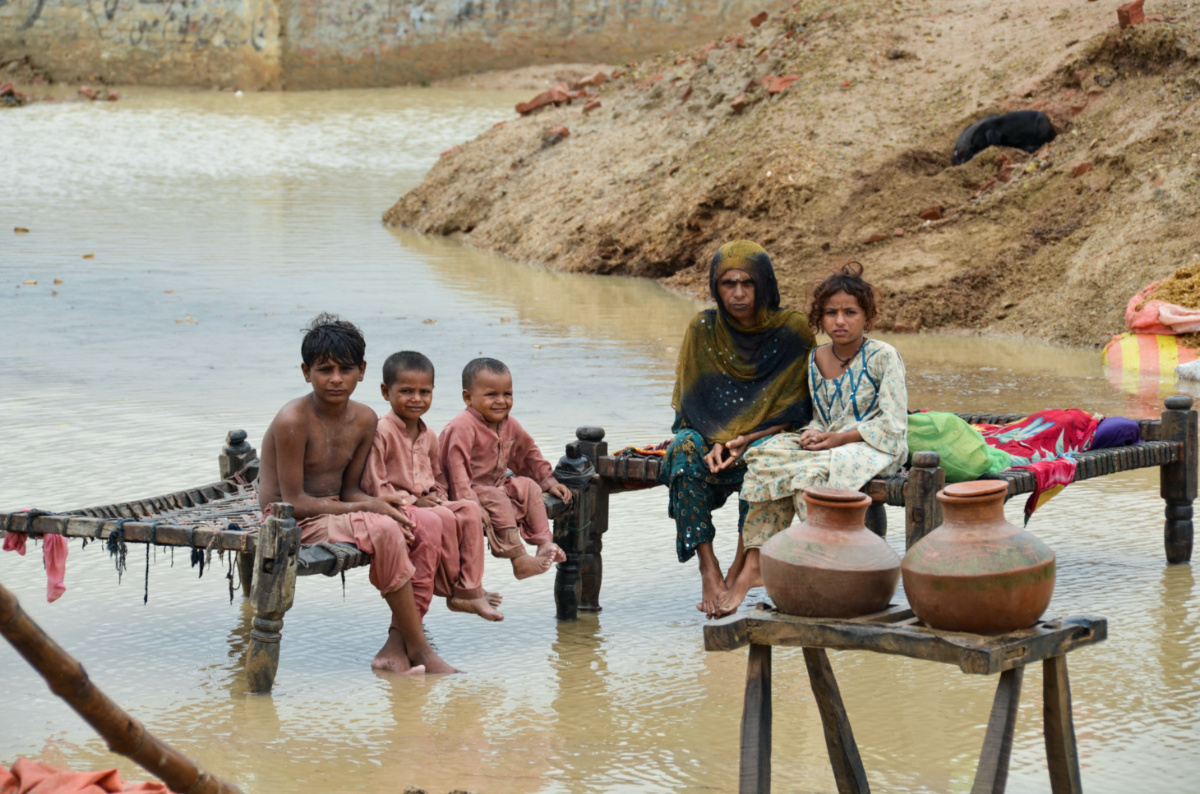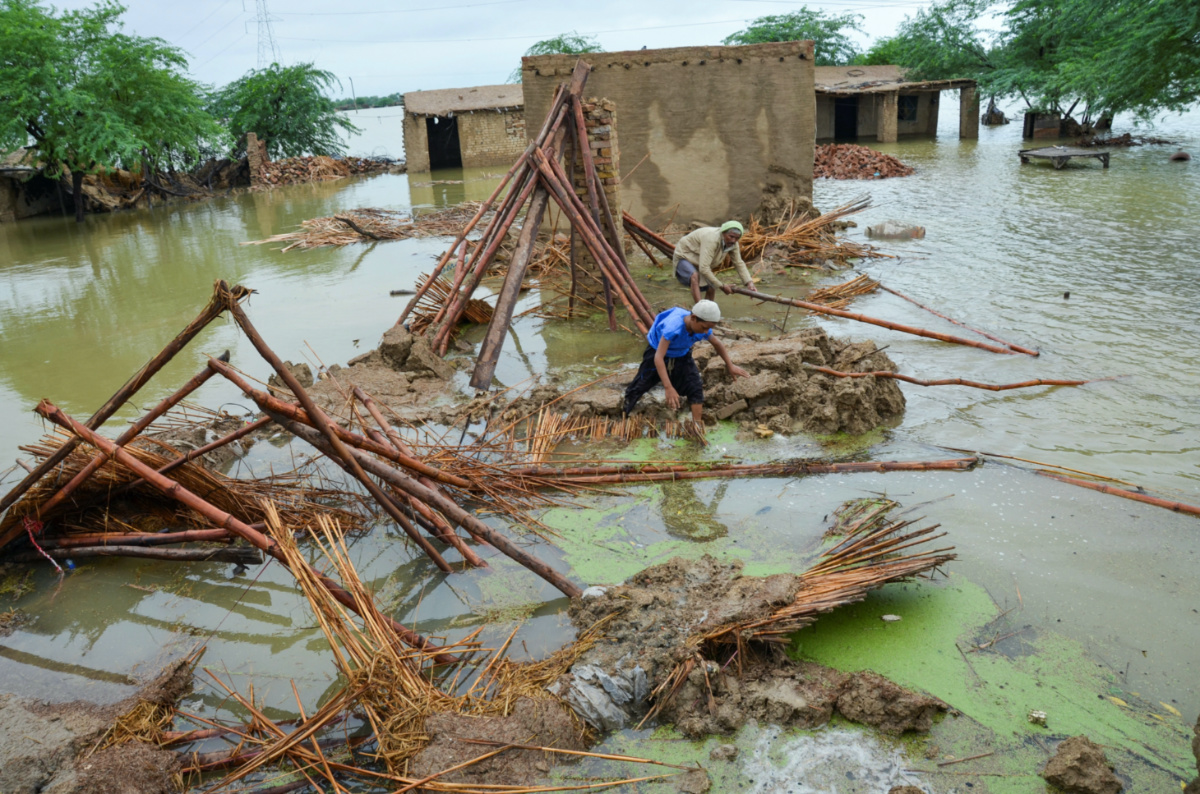Karachi, Pakistan
Reuters
Historic monsoon rains and flooding in Pakistan have affected more than 30 million people over the last few weeks, the country’s climate change minister said on Thursday, calling the situation a “climate-induced humanitarian disaster of epic proportions”.
Pakistan has urged the international community to help with relief efforts as it struggles to cope with the aftermath of torrential rains that have triggered massive floods since last month, killing more than 900 people.

A woman and children sit on rope beds amidst rain waters besides their damaged house following rains and floods during the monsoon season in Dera Allah Yar, district Jafferabad, Balochistan, Pakistan, on 25th August. PICTURE: Reuters/Amer Hussain
“33 million have been affected, in different ways; the final homeless figure is being assessed,” Climate Change Minister Sherry Rehman told Reuters in a text message.
DEATH TOLL FROM FLOODS IN AFGHANISTAN RISES ABOVE 180 – TALIBAN
Flooding in Afghanistan this month killed more than 180 people, the Taliban said on Thursday, appealing to the international community for help.
Flooding has wrought widespread devastation in central and eastern Afghan provinces in recent weeks, washing away thousands of houses and excacerbating the country’s economic and humanitarian crisis.
“The Islamic Emirate of Afghanistan can’t manage the floods alone, we ask the world, international organisations and Islamic countries to help us,” Taliban spokesman Zabihullah Mujahid said at a news conference.
Mujahid said 182 people had been killed by floods this month and 250 injured. More than 3,100 houses had been completely destroyed and thousands of livestock killed.
Afghanistan has been reeling from natural disasters this year, including a drought and an earthquake that killed more than 1,000 people in June. The nation has been largely cut off from the international financial system since the Taliban took over a year ago.
In Khoshi district in central Logar province, aid workers described widespread destruction from the powerful floods in recent days, with fields of crops reduced to mud and bodies of dead animals lying in piles.
Around 20,0000 people in the district were affected by flooding and 20 people, including at least six children, had been killed with two more missing, the UN children’s agency said.
“People lost everything…they lost everything overnight,” said Anne Kindrachuk, central region chief for UNICEF Afghanistan, said after a visit to the area.
“There are three tent communities or camps but [people] are unsure what comes next, how they are going to eat this winter, their livelihoods were wiped out,” she said.
– MOHAMMAD YUNUS YAWAR and CHARLOTTE GREENFIELD/Reuters
She added that the southern province of Sindh, hardest hit in the last few days, had requested one million tents for affected people.
“South of Pakistan is inundated almost underwater…People are going to higher ground,” she said.
“Needs assessment is being done, we have to make UN’s international flash appeal; this is not the task of one country or one province, it is a climate-induced disaster,” she added.
Minister for Planning and Development Ahsan Iqbal separately told Reuters that 30 million people had been affected, a figure that would represent about 15 per cent of the South Asian country’s population.
UN agency Office for the Coordination of Humanitarian Affairs said in an update on Thursday that the monsoon rains had affected some three million people in Pakistan of which 184,000 have been displaced to relief camps across the country.
Funding and reconstruction efforts will be a challenge for cash-strapped Pakistan, which is having to cut spending to ensure that the International Monetary Fund approves the release of much-needed bailout money.
The National Disaster Management Authority said in a report that in the last 24 hours 150 kilometres of roads had been damaged across the country and over 82,000 homes have been partially or fully damaged.
Since mid-June, when the monsoon began, over 3,000 kilometres of road, 130 bridges and 495,000 homes have been damaged, according to NDMA’s last situation report, figures also echoed in the OHCA report.
“The rain hasn’t stopped”
A vast majority of this damage is in the southern province of Sindh.
“Brother, the rain has not stopped for the past three months…We are living in a rickshaw with our children because the roof of our mud house is leaking,” a woman who declined to be named told Reuters TV in Hyderabad, Sindh’s second-largest city.
OCHA also warned that alerts had been issued for floods, river overflows, and landslides in several areas of Pakistan, and heavy rainfall was forecast for the next two days, too, over most of the country.
Seated with three of her children in the rickshaw she said: “Where can we go? The gutters are overflowing, and our courtyard is filled up with sewage. Our houses and alleys have turned into a floating garbage bin.”

People retrieve bamboo from a damaged house following rains and floods during the monsoon season in Dera Allah Yar, district Jafferabad, Balochistan, Pakistan, on 25th August. PICTURE: Reuters/Amer Hussain.
Rehman said Sindh has received “784 per cent” more rainfall this month than the August average, while the province of Balochistan had received nearly 500 per cent more.
Twenty three districts of Sindh have been declared calamity hit, she said.






